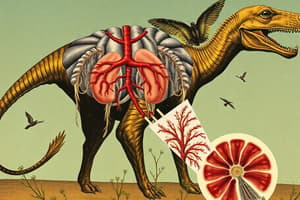Podcast
Questions and Answers
Which of the following is NOT a characteristic shared by both lineages of amniotes discussed in the text?
Which of the following is NOT a characteristic shared by both lineages of amniotes discussed in the text?
Diaspids, a group within reptilia, are characterized by having a single temporal fenestra in their skull.
Diaspids, a group within reptilia, are characterized by having a single temporal fenestra in their skull.
False (B)
What is the name of the extinct group of diapsids that included pterosaurs and dinosaurs?
What is the name of the extinct group of diapsids that included pterosaurs and dinosaurs?
Archosauromorphs
The group of diapsids known as ______ includes squamates (lizards and snakes) and sphenodon (tuataras).
The group of diapsids known as ______ includes squamates (lizards and snakes) and sphenodon (tuataras).
Signup and view all the answers
Match the following extinct synapsids with their dietary specialization:
Match the following extinct synapsids with their dietary specialization:
Signup and view all the answers
Synapsids, which gave rise to mammals, first appeared in the Devonian period.
Synapsids, which gave rise to mammals, first appeared in the Devonian period.
Signup and view all the answers
What is the primary function of the "sails" found in some pelycosaurs?
What is the primary function of the "sails" found in some pelycosaurs?
Signup and view all the answers
What is the name of the group of synapsids that includes mammals?
What is the name of the group of synapsids that includes mammals?
Signup and view all the answers
The extinct group of diapsids that includes crocodilians, birds, and dinosaurs is called ______.
The extinct group of diapsids that includes crocodilians, birds, and dinosaurs is called ______.
Signup and view all the answers
Birds are more closely related to crocodiles than they are to lizards.
Birds are more closely related to crocodiles than they are to lizards.
Signup and view all the answers
What is a notable characteristic of placoderms regarding their jaws?
What is a notable characteristic of placoderms regarding their jaws?
Signup and view all the answers
Placoderms had replaceable teeth similar to modern fish.
Placoderms had replaceable teeth similar to modern fish.
Signup and view all the answers
What allowed Dunkleosteus to be an effective predator?
What allowed Dunkleosteus to be an effective predator?
Signup and view all the answers
Chondrichthyans are characterized by a ____ skeleton, which limits their fossilization.
Chondrichthyans are characterized by a ____ skeleton, which limits their fossilization.
Signup and view all the answers
Match the following groups of Chondrichthyans with their examples:
Match the following groups of Chondrichthyans with their examples:
Signup and view all the answers
Which of the following groups includes jawless vertebrates?
Which of the following groups includes jawless vertebrates?
Signup and view all the answers
Lampreys possess a round mouth with keratinous teeth.
Lampreys possess a round mouth with keratinous teeth.
Signup and view all the answers
Name one of the major genera of hagfishes.
Name one of the major genera of hagfishes.
Signup and view all the answers
The two extant lineages of jawless vertebrates are Petromyzontiformes and ______.
The two extant lineages of jawless vertebrates are Petromyzontiformes and ______.
Signup and view all the answers
Match the following jawless fish with their characteristics:
Match the following jawless fish with their characteristics:
Signup and view all the answers
What defines the hallmark characteristic of placoderms?
What defines the hallmark characteristic of placoderms?
Signup and view all the answers
Ostracoderms are considered a monophyletic group within jawless fish.
Ostracoderms are considered a monophyletic group within jawless fish.
Signup and view all the answers
What type of structures are conodont elements believed to be?
What type of structures are conodont elements believed to be?
Signup and view all the answers
Which of the following groups are considered 'fleshy-finned' fishes?
Which of the following groups are considered 'fleshy-finned' fishes?
Signup and view all the answers
The upper jaw of extant Chimaeras is fused to the cranium.
The upper jaw of extant Chimaeras is fused to the cranium.
Signup and view all the answers
What is the primary function of the gas bladder in bony fishes?
What is the primary function of the gas bladder in bony fishes?
Signup and view all the answers
The term 'Osteichthyes' is derived from the Greek words "" and "" meaning 'bone' and 'fish' respectively.
The term 'Osteichthyes' is derived from the Greek words "" and "" meaning 'bone' and 'fish' respectively.
Signup and view all the answers
Match the following groups of vertebrates with their corresponding characteristics.
Match the following groups of vertebrates with their corresponding characteristics.
Signup and view all the answers
Which of the following is NOT a subclass within Actinopterygii?
Which of the following is NOT a subclass within Actinopterygii?
Signup and view all the answers
The evolutionary lineage of Lissamphibia dates back to the Triassic period.
The evolutionary lineage of Lissamphibia dates back to the Triassic period.
Signup and view all the answers
What is the defining characteristic that distinguishes Lissamphibia as a monophyletic group?
What is the defining characteristic that distinguishes Lissamphibia as a monophyletic group?
Signup and view all the answers
Among Lissamphibia, the ______ are the only ones that lack limbs and tails.
Among Lissamphibia, the ______ are the only ones that lack limbs and tails.
Signup and view all the answers
Which of the following features is NOT a characteristic of the dermal bone in bony fishes?
Which of the following features is NOT a characteristic of the dermal bone in bony fishes?
Signup and view all the answers
Study Notes
Vertebrate Evolution
- Vertebrates are animals with backbones.
- The evolutionary history of vertebrates is complex and spans millions of years
- A phylogenetic tree traces the evolutionary relationships between various vertebrate groups.
Agnatha (Jawless Fish)
- Hagfish and lampreys are examples of jawless fish.
- 75 species are all marine.
- Two main genera, Eptatretus and Myxine.
- Elongated body form and without scales.
- Color ranging from gray to purple.
- Scavengers and predators.
- 40 species in two genera, Petromyzon and Lampetra.
- Range in size from about 10 cm to 1 m.
- Found primarily in temperate northern regions.
- 7 pairs of gill pouches
- Large well developed eyes (possess color vision).
- Round mouth with keratinous teeth.
- Parasites of fish
Extinct Jawless Fish
- Ostracoderms were an extinct group.
- Ostracoderms represent a paraphyletic group.
- More derived than the extant agnathans.
- Lived from the Ordovician through Devonian periods.
- Conodonts are another extinct group.
- Mysterious early vertebrates; widespread in the fossil record, from Cambrian to Triassic.
- Spine or comb-like structures.
- Calcified like vertebrate hard tissues.
- Originally thought to be marine invertebrates
- Notochord.
- Myomeres.
- Complex pharynx formed with dentine and enamel.
- Found to be stem vertebrates.
Early Gnathostomes
- First fishes to have true jaws.
- 4 distinct groups:
- Placoderms (armored fish)
- Acanthodians (spiny sharks)
- Chondrichthyans (cartilaginous fishes)
- Osteichthyans (bony fishes)
- Mid-Devonian period
Placoderms
- Most primitive gnathostomes.
- Paraphyletic.
- Basal to other gnathostomes.
- Diverse, with over 200 genera.
- Divided into distinct head and trunk portions, with a joint connecting them.
- Primarily lacked teeth, having bony crushing/cutting plates instead.
- Plates were not replaceable.
- Covered with thick bony shield.
- Exoskeleton-heavily armored (similar to ostracoderms)
- Endoskeleton-mostly cartilaginous; some ossification.
- Generally considered bottom-dwellers.
- Dunkleosteus-up to 10 m long; large gape; top predator of the Devonian period.
Chondrichthyans
- Cartilaginous skeleton.
- Many extant genera appeared as early as the Triassic.
- Sharks, skates, rays, and chimaeras.
- Sub-terminal mouth.
- Solid calcified cartilaginous vertebrae.
- Centrum evolved to replace notochord.
- Enamel-like coating on teeth.
- Presence of claspers.
- Teeth not embedded in bone (composed of dentine and enameloid); teeth are continuously replaced (polyphyodont).
- Paleozoic holocephals. Basal to chimaeriformes; mid-Devonian. Shark-like teeth. Upper jaw not fused to the cranium. Helicoprion - elaborate teeth whorl like a circular saw.
Osteichthyans
- Bony fishes
- Osteon/"bone"
- Ichthyans
- Bony fishes
- Two major groups: -Sarcopterygians ("fleshy-finned" fishes) -Actinopterygians ("ray-finned" fishes)
- Includes groups like:
- Cladistia
- Chondrostei (sturgeons and paddlefish)
- Neopterygii (holostei, and teleostei).
Sarcopterygii
- "Fleshy-finned" fishes
- Rhipidistia
- Dipnomorpha (lungfish)
- Tetrapodomorpha (four-limbed vertebrates)
Lissamphibia
- Descendants of anamniotic tetrapods.
- Monophyletic group.
- Extant taxa date from the Triassic.
- General characteristics:
- Moist, gas-permeable skin.
- Respiration through skin (cutaneous respiration)
- Three subclades (orders):
- Caecilians (lack limbs)
- Salamanders (most with tails)
- Frogs (lack tails; terrestrial)
Synapsids and Sauropsids
- Two major clades of amniotes.
- Split into two lineages relatively early.
- Synapsids led to mammals and Sauropsids to other reptiles and birds.
Archosaurs
- Several lineages evolved within the archosauromorphs during the Mesozoic.
- Extant forms include turtles, crocodilians, birds, pterosaurs, and dinosaurs.
- Derived from a shared ancestor.
Birds
- Clearly derived therapod dinosaurs.
- Fossil evidence confirms their evolutionary path.
- Thomas Huxley considered them glorified reptiles.
Crocodilians
- Modern crocodilians are derived from a diverse group of crocodilomorphs.
- Largest extant reptiles.
Vertebrate Diversity (Various)
- Many extant genera appeared as early as the Triassic.
- Major extant diversity-sharks, skates, rays, and chimaeras.
- Different evolutionary changes, mouth position, and bone structure.
- Various important and unique characteristics/structures.
- Various extinct lineages, and when they appeared.
Studying That Suits You
Use AI to generate personalized quizzes and flashcards to suit your learning preferences.
Related Documents
Description
Explore the fascinating world of vertebrate evolution, focusing on jawless fish such as hagfish and lampreys. This quiz covers their characteristics, evolutionary relationships, and extinct jawless species like ostracoderms. Test your knowledge on the complexities of vertebrate history and the unique traits of agnathans.




